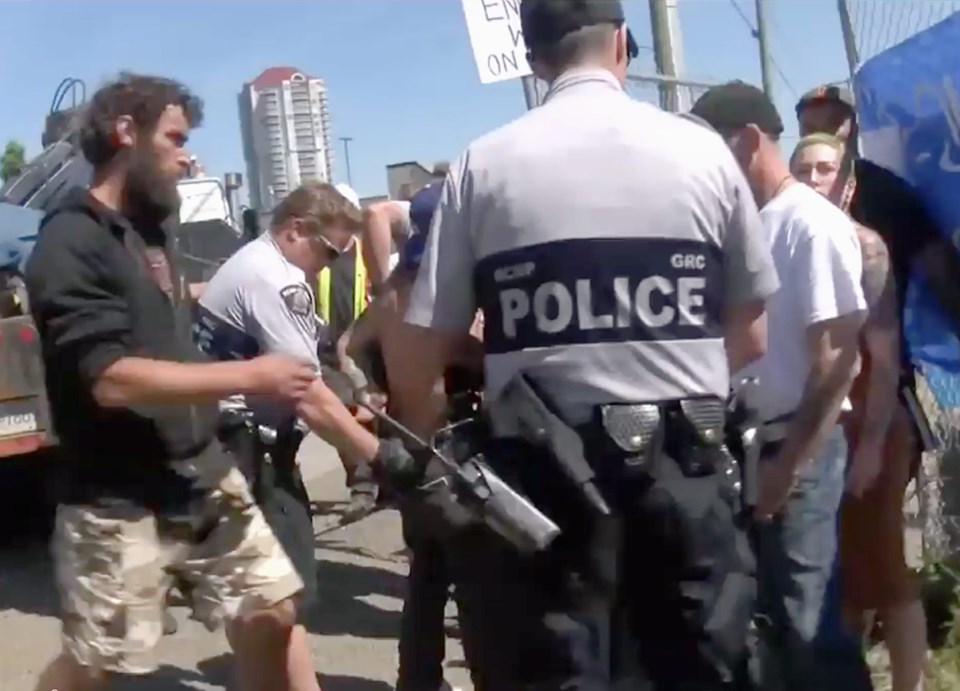Nanaimo municipal crews removed the entrance gate to a tent city and hauled it away on Tuesday as divisions among citizens widened.
Several people — police said four and activists said five — were arrested for blocking the gate. They were not charged and were released at the scene.
Each side cites safety as their key concern around the gate.
DisconTent City advocates said that a controlled gate is needed to maintain a safe, secure place for residents of the tent city. It protects them from anyone wishing to harm them from the outside, they said.
City hall said the gate had to go because emergency services — such as fire vehicles, ambulances and RCMP — must to be able to get inside if a situation arises.
Two overdoses and what a tent city organizer described as an allergic reaction to drugs have taken place since the tent city was set up on May 17.
Approximately 50 residents were at the camp on Tuesday.
This is Nanaimo’s second significant tent city in recent months.
A camp was established for 10 days in March on the lawn at Nanaimo City Hall. It came down after city council voted to spend $350,000 on measures to address the drug overdose crisis and help those in need of housing.
Nanaimo’s latest camp is at Front and Esplanade streets, on a vacant 8.4-acre industrial site owned by the City of Nanaimo and surrounded by an existing chain-link fence.
Mercedes Courtoreille, an organizer and housing advocate with the homeless community, said in an interview that she has spent the past two months working with the homeless community in Nanaimo, “planning DisconTent City to make a long-term sustainable protest camp.”
The goal is for a tent city that can “thrive in a location that’s appropriate, with community guidelines because it is a city within a city, and with the best interests of keeping everybody safe.”
There’s a protocol at the gate that no one is welcome inside without a good reason and that applies to police as well, she said in a statement.
“Every time the cops have come, we have listened to what they have to say, and if they are looking for a missing person or someone with a warrant or attending with an ambulance then we work with them, but if they don’t have a good reason to be here then they are not allowed in.
“Would you allow the police to come into your home in the middle of the night without reason? We don’t either.”
An group of tent-city residents meets regularly and everyone who joins the community must abide by rules. These include bans on gender violence, loud noise and stealing. As well, residents must ensure the camp is clean and anyone using drugs can not do so in the open.
Courtoreille said that tent city falls under provisions of the Canadian Charter of Rights and Freedoms to ensure safety of citizens. Previous tent cities have made this same argument.
She said that threats have been made on social media about “culling” people at the camp, throwing Molotov cocktails and hosing down the site.
Nanaimo Mayor Bill McKay said: “I just want to make sure that everybody down there is safe, regardless of who they might be.”
Municipal staff are compiling information which will be brought to Nanaimo council in the coming days, he said.
“There is no owner’s manual for this type of process so we rely on the experts to give us the best advice possible.”
The gate was taken away “so that emergency and fire can get in there,” he said. “As it stands right now, emergency and fire and public works are reluctant to go on the site without RCMP being there to assist and oversee,” McKay said.
“The campers have been extremely aggressive toward RCMP,” he said. “It is my understanding that they have had some confrontations.”
Emergency crews have had to respond twice to drug overdoses on the site, McKay said. “You’ve got an ambulance sitting outside the gate that refuses to go in unless he’s got an RCMP escort to go in.”
As well, if someone in distress is treated by emergency services by personnel who are 100 feet away from their equipment, “that doesn’t help in their response.”



